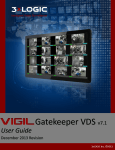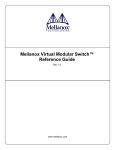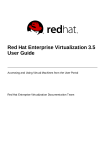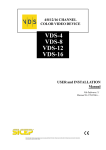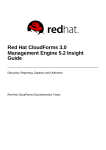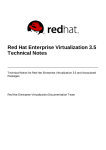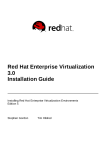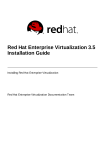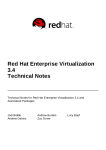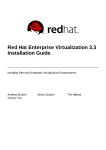Download Red Hat Enterprise Virtualization 3.5 Manager Release Notes
Transcript
Red Hat Enterprise Virtualization 3.5 Manager Release Notes Release notes for Red Hat Enterprise Virtualization Manager 3.5. Red Hat Enterprise Virtualization Documentation Team Red Hat Enterprise Virtualization 3.5 Manager Release Notes Release notes for Red Hat Enterprise Virtualization Manager 3.5. Red Hat Enterprise Virtualizatio n Do cumentatio n Team Red Hat Custo mer Co ntent Services rhev-do [email protected] m Legal Notice Co pyright © 20 15 Red Hat, Inc. This do cument is licensed by Red Hat under the Creative Co mmo ns Attributio n-ShareAlike 3.0 Unpo rted License. If yo u distribute this do cument, o r a mo dified versio n o f it, yo u must pro vide attributio n to Red Hat, Inc. and pro vide a link to the o riginal. If the do cument is mo dified, all Red Hat trademarks must be remo ved. Red Hat, as the licenso r o f this do cument, waives the right to enfo rce, and agrees no t to assert, Sectio n 4 d o f CC-BY-SA to the fullest extent permitted by applicable law. Red Hat, Red Hat Enterprise Linux, the Shado wman lo go , JBo ss, MetaMatrix, Fedo ra, the Infinity Lo go , and RHCE are trademarks o f Red Hat, Inc., registered in the United States and o ther co untries. Linux ® is the registered trademark o f Linus To rvalds in the United States and o ther co untries. Java ® is a registered trademark o f Oracle and/o r its affiliates. XFS ® is a trademark o f Silico n Graphics Internatio nal Co rp. o r its subsidiaries in the United States and/o r o ther co untries. MySQL ® is a registered trademark o f MySQL AB in the United States, the Euro pean Unio n and o ther co untries. No de.js ® is an o fficial trademark o f Jo yent. Red Hat So ftware Co llectio ns is no t fo rmally related to o r endo rsed by the o fficial Jo yent No de.js o pen so urce o r co mmercial pro ject. The OpenStack ® Wo rd Mark and OpenStack Lo go are either registered trademarks/service marks o r trademarks/service marks o f the OpenStack Fo undatio n, in the United States and o ther co untries and are used with the OpenStack Fo undatio n's permissio n. We are no t affiliated with, endo rsed o r spo nso red by the OpenStack Fo undatio n, o r the OpenStack co mmunity. All o ther trademarks are the pro perty o f their respective o wners. Abstract The Release No tes pro vide high-level co verage o f the impro vements and additio ns that have been implemented in Red Hat Enterprise Virtualizatio n 3.5. T able of Cont ent s T able of Contents . .hapt C . . . .er . .1. .. Int . . .roduct . . . . . .ion . . . . . . . . . . . . . . . . . . . . . . . . . . . . . . . . . . . . . . . . . . . . . . . . . . . . . . . . . . . . . . . . . . 2. . . . . . . . . . 1.1. Intro d uc tio n to Red Hat Enterp ris e Virtualiz atio n 2 1.2. Red Hat Sub s c rip tio n Manag er 2 . .hapt C . . . .er . .2. .. What . . . . .'s. .New? . . . . . . . . . . . . . . . . . . . . . . . . . . . . . . . . . . . . . . . . . . . . . . . . . . . . . . . . . . . . . . . . . . . . 5. . . . . . . . . . 2 .1. Co mp ute Features 5 2 .2. Sto rag e Features 5 2 .3. Netwo rking Features 5 2 .4. Infras truc ture Features 6 2 .5. Us er Exp erienc e Enhanc ements 6 . .hapt C . . . .er . .3. . .T. echnical . . . . . . . . Not . . . es . . . . . . . . . . . . . . . . . . . . . . . . . . . . . . . . . . . . . . . . . . . . . . . . . . . . . . . . . . . . . . . 7. . . . . . . . . . 3 .1. Features 7 3 .2. Enhanc ements 8 3 .3. Kno wn Is s ues 3 .4. Dep rec ated Func tio nalities 3 .5. Sec urity 20 25 26 . . . . . . . . .Hist Revision . . . ory . . . . . . . . . . . . . . . . . . . . . . . . . . . . . . . . . . . . . . . . . . . . . . . . . . . . . . . . . . . . . . . . . . . . . . . .2. 7. . . . . . . . . . 1 Red Hat Ent erprise Virt ualiz at ion 3.5 Manager Release Not es Chapter 1. Introduction 1.1. Int roduct ion t o Red Hat Ent erprise Virt ualiz at ion Red Hat Enterprise Virtualization is a feature-rich server and desktop virtualization management system. It provides advanced capabilities for managing virtualization hosts and virtualized guests. To install Red Hat Enterprise Virtualization Manager and virtualization hosts, your systems must be registered using Red Hat Subscription Management (RHSM). Important A clean installation is recommended for Red Hat Enterprise Virtualization 3.5. 1.2. Red Hat Subscript ion Manager 1.2.1. Red Hat Subscript ion Manager Ent it lement s and Reposit ories Important If your current systems are registered to RHN Classic, see Migrating from RHN Classic to Red Hat Subscription Management (RHSM) for Red Hat Enterprise Virtualization to migrate your systems to RHSM. The Red Hat Subscription Manager (RHSM) provides packages necessary for installing Red Hat Enterprise Virtualization Manager and virtualization hosts. T ab le 1.1. R eq u ired R ep o sit o ries f o r R ed H at En t erp rise Virt u aliz at io n Man ag er Su b scrip t io n p o o l R ep o sit o ry n ame R ep o sit o ry lab el D et ails R ed Hat Enterpri se Li nux Server R ed Hat Enterpri se Li nux Server R ed Hat Enterpri se Li nux Server R HEL Server Suppl ementary rhel -6 -serverrpms R ed Hat Enterpri se Vi rtual i zati o n R ed Hat Enterpri se Vi rtual i zati o n R ed Hat Enterpri se Vi rtual i zati o n R ed Hat JBo ss Enterpri se Appl i cati o n P l atfo rm rhel -6 -serverrhevm-3. 5-rpms Provides the Red Hat Enterprise Linux 6 Server. Provides the virtio-win package, which provides the Windows VirtIO drivers for use in virtual machines. Provides the Red Hat Enterprise Virtualization Manager. Provides the supported release of Red Hat JBoss Enterprise Application Platform on which the Manager runs. 2 rhel -6 -serversuppl ementaryrpms jb-eap-6 -fo rrhel -6 -serverrpms Chapt er 1 . Int roduct ion T ab le 1.2. R eq u ired R ep o sit o ries f o r R ed H at En t erp rise Virt u aliz at io n H yp erviso r Su b scrip t io n p o o l R ep o sit o ry n ame R ep o sit o ry lab el D et ails R ed Hat Enterpri se Vi rtual i zati o n R ed Hat Enterpri se Vi rtual i zati o n rhel -6 -serverrhevh-rpms R ed Hat Enterpri se Vi rtual i zati o n R ed Hat Enterpri se Vi rtual i zati o n rhel -7-serverrhevh-rpms Provides the rhevhypervisor package, which includes the image required to install the hypervisor. Provides the rhevhypervisor package, which includes the image required to install the hypervisor. T ab le 1.3. R eq u ired R ep o sit o ries f o r R ed H at En t erp rise Lin u x 7 H o st Su b scrip t io n p o o l R ep o sit o ry n ame R ep o sit o ry lab el D et ails R ed Hat Enterpri se Li nux Server R ed Hat Enterpri se Li nux Server R ed Hat Enterpri se Li nux Server R ed Hat Enterpri se Li nux 7 Server O pti o nal R ed Hat Enterpri se Vi rtual i zati o n R ed Hat Enterpri se Vi rtual i zati o n Manag ement Ag ents (R P Ms) rhel -7-server-rpms Provides the Red Hat Enterprise Linux 7 Server. rhel -7-serverProvides the sanlock o pti o nal -rpms package and sanlockrelated packages required for using Red Hat Enterprise Linux 7 servers as virtualization hosts. rhel -7-serverProvides the QEMU rhev-mg mt-ag entand KVM packages rpms required for using Red Hat Enterprise Linux 7 servers as virtualization hosts. T ab le 1.4 . R eq u ired R ep o sit o ries f o r R ed H at En t erp rise Lin u x 6 H o st Su b scrip t io n p o o l R ep o sit o ry n ame R ep o sit o ry lab el D et ails R ed Hat Enterpri se Li nux Server R ed Hat Enterpri se Li nux Server R ed Hat Enterpri se Li nux Server R ed Hat Enterpri se Li nux 6 Server O pti o nal rhel -6 -serverrpms R ed Hat Enterpri se Vi rtual i zati o n R ed Hat Enterpri se Vi rtual i zati o n Manag ement Ag ents (R P Ms) rhel -6 -serverrhev-mg mt-ag entrpms Provides the Red Hat Enterprise Linux 6 Server. Provides the sanlock package and sanlockrelated packages required for using Red Hat Enterprise Linux 6 servers as virtualization hosts. Provides the QEMU and KVM packages required for using Red Hat Enterprise Linux 6 servers as virtualization hosts. rhel -6 -servero pti o nal -rpms 3 Red Hat Ent erprise Virt ualiz at ion 3.5 Manager Release Not es 1.2.2. Addit ional Packages from Cont ent Delivery Net work The packages provided in the following repositories are not strictly required to install and configure a functioning Red Hat Enterprise Virtualization environment, however they provide additional capabilities to enhance the user experience. T ab le 1.5. R eco mmen d ed R ep o sit o ries f o r R ed H at En t erp rise Virt u aliz at io n Su b scrip t io n p o o l R ep o sit o ry n ame R ep o sit o ry lab el D et ails R ed Hat Enterpri se Li nux Server R HEL Server Suppl ementary (v. 6 6 4 -bi t x86 _6 4 ) rhel -6 -serversuppl ementaryrpms R ed Hat Enterpri se Li nux Server R HEL Suppl ementary EUS (v. 5. 9 . z fo r 6 4 -bi t x86 _6 4 ) rhel -5. 9 . zserversuppl ementaryrpms R ed Hat Enterpri se Li nux Server R ed Hat Enterpri se Li nux 7 Server - R H C o mmo n (v. 7 Server fo r x86 _6 4 ) rhel -7-server-rhco mmo n-rpms R ed Hat Enterpri se Li nux Server R ed Hat Enterpri se Vi rt Ag ent (v. 6 Server fo r x86 _6 4 ) rhel -6 -serverrhev-ag ent-rpms R ed Hat Enterpri se Li nux Server R ed Hat Enterpri se Vi rt Ag ent (v. 5 Server fo r x86 _6 4 ) rhel -5-serverrhev-ag ent-rpms Provides the spice-usbshare and kmodkspiceusb-rhel60 packages for Red Hat Enterprise Linux 6, which enables USB redirection (legacy mode) on Red Hat Enterprise Linux 6 clients. Provides the spice-usbshare and kmodkspiceusb-rhel5u6 packages for Red Hat Enterprise Linux 5, which enables USB redirection (legacy mode) on Red Hat Enterprise Linux 5 clients. Provides the rhevmguest-agent-common package for Red Hat Enterprise Linux 7, which allows you to monitor virtual machine resources on Red Hat Enterprise Linux 7 clients. Provides the rhevmguest-agent-common package for Red Hat Enterprise Linux 6, which allows you to monitor virtual machine resources on Red Hat Enterprise Linux 6 clients. Provides the rhevguest-agent package for Red Hat Enterprise Linux 5, which allows you to monitor virtual machine resources on Red Hat Enterprise Linux 5 clients. 4 Chapt er 2 . What 's New? Chapter 2. What's New? 2.1. Comput e Feat ures Red Hat Enterprise Virtualization 3.5 provides optimized performance and resource allocation features including: N U MA Su p p o rt in clu d in g H o st N U MA, N U MA G u est Pin n in g , an d Virt u al N U MA This functionality allows customers to provision large guest workloads while minimizing the overhead of physical memory access on compatible hosts. Ext en d ed SLA/Q o S Su p p o rt Administrators can now define D isk and CPU resource limits to prevent over utilization and unpredictable virtual machine performance issues. o Virt O p t imiz er In t eg rat io n Administrators can now identify the optimal balance of virtual machines within a cluster. In addition, administrators can determine how to place new virtual machine workloads into a cluster with enough total available resources, and avoid scenarios whereby no single host has enough resources for a new virtual machine. 2.2. St orage Feat ures Self - H o st ed En g in e iSC SI su p p o rt With this feature, users can use iSCSI storage for Self-Hosted Engine data domain. Su p p o rt live d elet io n o f a sn ap sh o t With this feature, you can now delete virtual machine disk snapshots from running virtual machines. The feature is supported in Red Hat Enterprise Virtualization 3.5 with hosts running Red Hat Enterprise Linux 7.1 or Red Hat Enterprise Virtualization Hypervisor 7.1. Ad van ced sn ap sh o t o verview cap ab ilit ies Users can now select storage consumption details on a disk or snapshot level for an easier removal process. Imp ro ved st o rag e d o main man ag emen t f o r d isast er reco very Red Hat Enterprise Virtualization 3.5 provides support for migrating storage domains amongst different Red Hat Enterprise Virtualization data centers or different deployments. This functionality allows the transfer of virtual machines between setups without the need to copy the data into and out of an export domain, or the need to recover after the loss of an engine database. SLA f o r st o rag e I/O b an d wid t h Administrators can now define I/O bandwidth limits to enhance VM I/O operations. 2.3. Net working Feat ures 5 Red Hat Ent erprise Virt ualiz at ion 3.5 Manager Release Not es Red Hat Enterprise Virtualization 3.5 delivers network capabilities that fully support enterprise virtualization infrastructures and deliver agility and flexibility to accommodate evolving workloads. Key new features include: Self - H o st ed En g in e VLAN su p p o rt The o vi rt-ho sted -eng i ne-setup was enhanced to support the configuration of VLAN tagged interfaces. En h an ced n et wo rk in t erf aces mo n it o rin g New events were introduced to notify the user in the case of NIC or bond failures. Ab ilit y t o co n f ig u re cu st o miz ed b rid g in g o p t io n s It is now possible to provide any configurable values of a Linux bridge, which serves as the basis for logical networks, through Red Hat Enterprise Virtualization Manager. This allows users to configure any parameters they need to meet specific network requirements. 2.4 . Infrast ruct ure Feat ures Red Hat Enterprise Virtualization 3.5 allows administrators to customize authentication and authorization processes according to specific organization needs. Furthermore, the release allows administrators to customize the user interface. New features to support this functionality include: Sat ellit e in t eg rat io n This feature adds the capability to provision Red Hat Enterprise Virtualization on baremetal machines and add them as hypervisors to Red Hat Enterprise Virtualization Manager using Foreman and Satellite. G en eric LD AP p ro vid er su p p o rt This feature enables the choice of using generic LD AP providers to authenticate users. En h an ced real t ime d at a in u ser in t erf ace The graphical user interface of the Administration Portal has been improved and now shows various real-time data including live migration status and progress, as well as the performance states of hosts and virtual machines. Su p p o rt lin k- d o wn d et ect io n o f p o wer man ag emen t LAN This feature adds support for a periodic health check for all hosts with power management enabled. The health check detects and raises alerts failed operations on the LAN. 2.5. User Experience Enhancement s Su p p o rt f o r sin g le sig n - o n t o Ad min ist rat io n an d U ser Po rt als ( T ech Preview) This feature supports single sign-on to User and Administration Portals. N ew g rap h ical u ser in t erf ace f o r t h e Ad min ist rat io n Po rt al an d U ser Po rt al With this release, the graphical user interfaces for the Administration Portal and User Portal have been updated to provide Red Hat customers with better unified interface experience across products. After upgrading to the 3.5 version, clear your browser cache to see the updated interface. 6 Chapt er 3. T echnical Not es Chapter 3. Technical Notes 3.1. Feat ures R FEs B Z #1077284 This feature introduces several updates to the handling of MAC address pools using the engine-config command. Previously, attempting to configure large ranges of MAC addresses would raise out of memory exceptions under certain circumstances, most typically on engine startup. Moreover, specifying a range of MAC addresses that contained an invalid address would cause the operation to fail. Now, users can configure a MAC address pool with larger address ranges, and invalid MAC addresses are filtered out of the range. However, if no valid MAC addresses remain after filtering, the operation fails. In addition, the MaxMacsCountInPool configuration value has been deprecated, and only the MacPoolRanges configuration value is now considered when allocating MAC addresses. Red Hat recommends configuring the MAC address pool to contain the majority of MAC addresses to be used; only MAC addresses defined in the MAC address pool are stored in memory efficiently. See http://bugzilla.redhat.com/show_bug.cgi?id=1077284 B Z #1154 352 Previously, different Simple Network Management Protocol (SNMP) traps were sent by ovirtengine-notifier for different events. Now, one generic SNMP trap, that contains the event data as Protocol D ata Units (PD U), is used for all event types and a Management Information Base (MIB) file has been created to describe the SNMP traps. In addition, the PD U list has been extended. See http://bugzilla.redhat.com/show_bug.cgi?id=1154352 B Z #716 511 Red Hat Enterprise Virtualization 3.5 provides support for migrating storage domains amongst different Red Hat Enterprise Virtualization data centers or different deployments. This functionality allows the transfer of virtual machines between setups without the need to copy the data into and out of an export domain, or the need to recover after the loss of an engine database. Also see BZ #920708 for the REST API implementation. See http://bugzilla.redhat.com/show_bug.cgi?id=716511 B Z #723211 With this feature, users can now clone a virtual machine directly from an existing virtual machine without the need to first create a template, making the process more time and resource efficient. See http://bugzilla.redhat.com/show_bug.cgi?id=723211 B Z #9 6 74 6 6 In the Administration Portal, a progress bar is now available to indicate the progress of migrating a running virtual machine. See http://bugzilla.redhat.com/show_bug.cgi?id=967466 7 Red Hat Ent erprise Virt ualiz at ion 3.5 Manager Release Not es o virt - en g in e- web ad min - p o rt al B Z #1114 24 1 With this update, when editing the " Setup Host Networks" window, the " Save Network Configuration" check box is now marked by default to prevent user configuration changes wiped by accident. See http://bugzilla.redhat.com/show_bug.cgi?id=1114241 vd sm B Z #1125237 Previously, the logging level of libvirt was set to debug mode, which greatly increased log file size and negatively impacted performance for production environments. Now, the default logging level of libvirt is used and verbosity is decreased. If '/run/systemd/journal/socket' exists on the machine, libvirt’s log file may be changed to journal. Refer to http://libvirt.org/logging.html for more information on the journal change. See http://bugzilla.redhat.com/show_bug.cgi?id=1125237 rh evm- ap p lian ce B Z #1029 507 This feature adds a virtual appliance, which can be used to quickly setup a pre-installed and partially pre-configured image of Red Hat Enterprise Virtualization Manager. The image is available for download as either a raw disk or an OVA file. The following command can be used inside the image to complete the site-specific configuration: $ rhevm-setup --offline --config-append=rhevm-setup-answers See http://bugzilla.redhat.com/show_bug.cgi?id=1029507 o virt - en g in e- b acken d B Z #9 8729 5 With this release, support for periodic power management health check to detect and warn about link-down of power management LAN has been added. See http://bugzilla.redhat.com/show_bug.cgi?id=987295 3.2. Enhancement s This release of Red Hat Enterprise Virtualization features the following enhancements: B Z #584 6 25 The new generic LD AP provider will fetch group information and 'userPrincipalName' from the Global Catalog in order to work properly in multiple domain installations. See https://bugzilla.redhat.com/show_bug.cgi?id=584625 B Z #6 5059 3 8 Chapt er 3. T echnical Not es With the new LD AP implementation provided by the ovirt-engine-extension-aaa-ldap package, you can now query an LD AP service using the site's D NS service record. For example: pool.default.serverset.srvrecord.service = ldap pool.default.serverset.srvrecord.protocol = tcp pool.default.serverset.srvrecord.domain = MYSITE._sites.ad.dc._msdcs.my-activedirecotry.com For more information, refer to ovirtengine-exntesion-aaa-ldap package documentation. See https://bugzilla.redhat.com/show_bug.cgi?id=650593 B Z #76 6 6 01 The new LD AP generic provider ovirt-engine-extension-aaa-ldap fully supports multiple Active D irectory forests. See https://bugzilla.redhat.com/show_bug.cgi?id=766601 B Z #800155 This features adds the ability to disable copying and pasting to virtual machines through SPICE connections, allowing administrators to restrict this functionality due to security reasons. This functionality is enabled by default. See https://bugzilla.redhat.com/show_bug.cgi?id=800155 B Z #804 530 This feature changes the " Slot" field to " Service Profile" when cisco_ucs is selected as the fencing type. See https://bugzilla.redhat.com/show_bug.cgi?id=804530 B Z #817180 With this release, MachineObjectOU is now available for configuration for virtual machines that are using Sysprep. This allows users to specify an Active D irectory OU for virtual machines to join. See https://bugzilla.redhat.com/show_bug.cgi?id=817180 B Z #8214 9 3 When a multi-processor virtual machine communicates with other virtual machines on the same host, its CPU may generate traffic faster than a single virtio-net queue can consume it. This feature aims to avoid this bottle neck by allowing multiple queues per virtual network interface. Note that this is effective only when the host runs a Red Hat Enterprise Linux 7 kernel >= 3.10.0-9.el7. See https://bugzilla.redhat.com/show_bug.cgi?id=821493 B Z #82859 1 Administrators can now identify the optimal balance of virtual machines within a cluster. In addition, administrators can determine how to place new virtual machine workloads into a cluster with enough total available resources, and avoid scenarios whereby no single host has enough resources for a new virtual machine. See https://bugzilla.redhat.com/show_bug.cgi?id=828591 B Z #859 024 9 Red Hat Ent erprise Virt ualiz at ion 3.5 Manager Release Not es When performing actions such as unplugging a Virtual NIC, a confirmation dialog is displayed to prevent user performing the action by accident. See https://bugzilla.redhat.com/show_bug.cgi?id=859024 B Z #874 328 With this enhancement, a new instance management screen is now available in the Administration Portal. See https://bugzilla.redhat.com/show_bug.cgi?id=874328 B Z #877209 A new package ovirt-optimizer is included in Red Hat Enterprise Virtualization. This package installs a new scheduler service that utilizes probabilistic methods to compute steps for starting a virtual machine and load balancing clusters. This feature was implemented because the existing internal scheduler only sees one step ahead and is not capable of computing complicated migration sequences. A virtual machine that is too large to start on any host directly can be accommodated by following migration hints from the Optimizer. More in-depth description can be found in the feature page http://www.ovirt.org/Features/Optaplanner and in the presentation here: http://www.ovirt.org/images/c/c6/Smart-VM-scheduling.pdf See https://bugzilla.redhat.com/show_bug.cgi?id=877209 B Z #8786 6 2 With this update, you can now set up custom fence agents for your Red Hat Enterprise Virtualization 3.5 environment. For more information, see https://access.redhat.com/articles/1238743. See https://bugzilla.redhat.com/show_bug.cgi?id=878662 B Z #879 077 Previously,when an entity changed, the system tree was not automatically refresh and users had to press the refresh button to update the tree. With this update, when an entity changes, the system tree will refresh automatically. See https://bugzilla.redhat.com/show_bug.cgi?id=879077 B Z #89 4 084 With this enhancement, a warning message is displayed in the user interface if SELinux is disabled to remind users of the SELinux status. See https://bugzilla.redhat.com/show_bug.cgi?id=894084 B Z #89 5222 In the Administration Portal, users can sort tables by clicking on column headers. See https://bugzilla.redhat.com/show_bug.cgi?id=895222 B Z #9 06 24 3 10 Chapt er 3. T echnical Not es This features adds the ability to configure the host name of a virtual machine using sysprep. See https://bugzilla.redhat.com/show_bug.cgi?id=906243 B Z #9 06 9 38 With this update, support for storage quality of service has been added. See https://bugzilla.redhat.com/show_bug.cgi?id=906938 B Z #9 18138 With this enhancement, it is now possible to configure serial numbers for virtual machines on three different levels: engine-config level, cluster level, and virtual machine level. At each level, three modes of serial numbers are available: use host UUID (legacy), use VM UUID , and provide custom serial number ______. See https://bugzilla.redhat.com/show_bug.cgi?id=918138 B Z #9 20171 Network bonds can now be automatically configured during installation using the 'bond_setup=' and 'bond=' kernel arguments. See https://bugzilla.redhat.com/show_bug.cgi?id=920171 B Z #9 22377 Previously, only certain virtual machine properties could be updated while the virtual machine was running. Other properties could only be updated while the virtual machine was down. Now, all properties can be updated on a running virtual machine, but those that cannot be applied immediately will be saved and applied the next time the virtual machine is shut down. See https://bugzilla.redhat.com/show_bug.cgi?id=922377 B Z #9 55235 With this feature, BIOS boot menu for virtual machines is now supported. This feature eases selecting boot options when needed. See https://bugzilla.redhat.com/show_bug.cgi?id=955235 B Z #9 6 0379 Partial configuration of kdump is now supported during auto-installation of the Red Hat Enterprise Virtualization Hypervisor. 'kdump_local=1' can now be used to store core dumps locally, and 'kdump_ssh' and 'kdump_ssh_key' can be used to configure kdump for remote storage of the core dump. See https://bugzilla.redhat.com/show_bug.cgi?id=960379 B Z #9 6 2220 This feature adds the ability to configure the system, user, and machine locale for a virtual machine using sysprep in the New Virtual Machine and Edit Virtual machine window. See https://bugzilla.redhat.com/show_bug.cgi?id=962220 B Z #9 6 2880 11 Red Hat Ent erprise Virt ualiz at ion 3.5 Manager Release Not es With this enhancement, when a grid is loaded and it contains only one item and it can be selected, the system will automatically select that item and display the detailed information of that item. This feature saves the user from manually clicking the item. See https://bugzilla.redhat.com/show_bug.cgi?id=962880 B Z #9 6 39 36 The new LD AP provider ovirt-engine-extension-aaa-ldap fully supports SSL/TLS and startTLS protocols. See https://bugzilla.redhat.com/show_bug.cgi?id=963936 B Z #9 6 6 302 This feature enables the default console device to be set from within the Red Hat Enterprise Virtualization Hypervisor setup TUI. See https://bugzilla.redhat.com/show_bug.cgi?id=966302 B Z #9 77079 This feature adds support for enabling a paravirtualized random number generator (RNG) in virtual machines. To use this feature, the random number generator source must be set at cluster level to ensure all hosts support and report desired RNG device sources. This feature is supported in Red Hat Enterprise Linux hosts of version 6.6 and higher. See https://bugzilla.redhat.com/show_bug.cgi?id=977079 B Z #9 77306 This enhancement adds information about password validity to console.vv files. It affects 'Native client' console invocation for SPICE and VNC. See https://bugzilla.redhat.com/show_bug.cgi?id=977306 B Z #9 809 6 5 The new generic LD AP provider implementation ovirt-engine-extension-aaa-ldap supports anonymous bind. You can now perform anonymous access to search for user information and no longer need to set up a specific user to perform directory search. See https://bugzilla.redhat.com/show_bug.cgi?id=980965 B Z #9 859 4 5 The Red Hat Enterprise Virtualization Manager websocket proxy can now be installed and configured (via engine-setup) on a separate machine from the machine on which the Manager is installed. See https://bugzilla.redhat.com/show_bug.cgi?id=985945 B Z #9 8729 9 With this update, you can now set event notifications for NIC slave or bond faults, provided there is a network or label on the interface. Four new events have been made available for selection to configure your event notifier. They are: HOST_INTERFACE_STATE_UP, HOST_INTERFACE_STATE_D OWN, HOST_BOND _SLAVE_STATE_UP, and HOST_BOND _SLAVE_STATE_D OWN. To enable or update your event notifier, subscribe to ovirt-engine-notifier to receive notifications on your selected events. See the Administration Guide, Configuring Event Notifications for more information. 12 Chapt er 3. T echnical Not es See https://bugzilla.redhat.com/show_bug.cgi?id=987299 B Z #9 8839 2 With this update, users now have the option to dismiss unwanted alerts from the Administration Portal. See https://bugzilla.redhat.com/show_bug.cgi?id=988392 B Z #9 9 6 512 Users can now log in to a virtual machine (with guest agent installed) via the REST API, using the new 'logon' action. This functionality was already available in the UI. The Manager sends the login credentials to the guest agent, which starts a session of the guest operating system and unlocks the display. See https://bugzilla.redhat.com/show_bug.cgi?id=996512 B Z #9 9 9 9 75 Previously if a vlan device had a non-standard name (the standard is- " dev.VLANID " ), the engine couldn't handle and display it. This feature adds the functionality to display such vlan devices. p.s- those devices are just displayed in host->network interfaces sub tab. Setup networks operations cannot be performed on them. See https://bugzilla.redhat.com/show_bug.cgi?id=999975 B Z #1014 134 Previously, the data warehouse service became unresponsive and got an OutOfMemoryError on service start when the hourly aggregation tried to aggregate around 1.5 million records. With this update, the service now aggregates per hour of the day and then proceeds to the next hour. This way, data aggregation is now scalable. See https://bugzilla.redhat.com/show_bug.cgi?id=1014134 B Z #1015186 When a block storage domain exceeds a certain number of logical volumes defined in a configuration value, each action that results in the creation of a new logical volume on the domain will add an audit log warning that the number of logical volumes on that domain has exceeded the defined number. The number of logical volumes is defined in the configuration value 'AlertOnNumberOfLVs' and it's default value is 300. See https://bugzilla.redhat.com/show_bug.cgi?id=1015186 B Z #1016 9 16 With this update, you can now search for virtual machines in the Administration Portal using their MAC addresses. See https://bugzilla.redhat.com/show_bug.cgi?id=1016916 B Z #10184 16 It is now possible to create ad hoc reports that have full details of users including more information than the user's ID number. The user's first and last name will now be visible on the report as well. 13 Red Hat Ent erprise Virt ualiz at ion 3.5 Manager Release Not es See https://bugzilla.redhat.com/show_bug.cgi?id=1018416 B Z #102279 5 Previously, when creating a virtual machine disk , the Administration Portal suggested a default disk alias consisting of 'VMname+_disk+number. The number came from the total amount of virtual machines disks plus 1. For example, for a virtual machine name 'V1' with 3 existing disks, the suggested name was'V1_disk4. However, the suggestion mode didn't recycle disks aliases correctly. If a disk was deleted, the number was not reused. With this update, the suggestion mode recycled the unused numbers to form new virtual machine disk aliases. See https://bugzilla.redhat.com/show_bug.cgi?id=1022795 B Z #1025376 The 'Change CD ' window now displays the name of the CD that is currently attached to a virtual machine. See https://bugzilla.redhat.com/show_bug.cgi?id=1025376 B Z #1025822 With this feature, a new command line option " ISNOREBOOT" was added to guest tools. When the option is used as part of a silent install (together with " ISSILENTMOD E" ), it disables the reboot of the machine at the end of the installation, allowing additional steps to be performed prior to rebooting the machine. See https://bugzilla.redhat.com/show_bug.cgi?id=1025822 B Z #1025831 With this update, you can configure the administrator password and organization name in the Initial Run tab of the Run Once menu. See https://bugzilla.redhat.com/show_bug.cgi?id=1025831 B Z #1029 507 This feature adds a virtual appliance, which can be used to quickly set up a pre-installed and partially pre-configured image of Red Hat Enterprise Virtualization Manager. The image is available for download as either a raw disk or an OVA file. The following command can be used inside the image to finish the site-specific configuration: $ rhevm-setup --offline --config-append=rhevm-setup-answers See https://bugzilla.redhat.com/show_bug.cgi?id=1029507 B Z #10326 86 Previously, all virtual machine OVFs were stored on the master domain and are being updated asynchronously by the OvfAutoUpdater. With this feature, OVFs are now stored on all wanted domains to provide better recovery ability, and to reduce the use of master_fs and the master domain. See https://bugzilla.redhat.com/show_bug.cgi?id=1032686 B Z #1034 885 With this update, users can now see the overview of snapshots in the Administration Portal. 14 Chapt er 3. T echnical Not es See https://bugzilla.redhat.com/show_bug.cgi?id=1034885 B Z #10386 32 This enhancement adds a button to the SPICE-HTML5 page and allows users to display console debug information when needed. See https://bugzilla.redhat.com/show_bug.cgi?id=1038632 B Z #1039 231 Support for Broadcom Corporation NetLink BCM57780 Gigabit Ethernet PCIe has been added to the Red Hat Enterprise Virtualization Hypervisor. See https://bugzilla.redhat.com/show_bug.cgi?id=1039231 B Z #104 4 033 With this feature, you can now configure ethtool options from Red Hat Enterprise Virtualization Manager. Previously, the Manager only configures a small subset of the values of a network interface. Users now have the option to use the ethtool utility to customize their usage of network interface. The engine-config tool has to be used initially for the " ethtool_opts" key to be made available. These custom properties are accessible through the Administration Portal, REST API, and software development kits. See https://bugzilla.redhat.com/show_bug.cgi?id=1044033 B Z #104 4 04 2 With this feature, users can now configure bridging options from Red Hat Enterprise Virtualization Manager. Previously, the Manager only configures a small subset of values of a linux bridge. Users who made customized configuration changes would find the configuration overridden by the Manager. Bridging options can now be supplied when provisioning a network on a host using the " bridge_opts" key. These custom properties are accessible through the Administration Portal, REST API, and software development kits. See https://bugzilla.redhat.com/show_bug.cgi?id=1044042 B Z #104 8019 This feature optimizes queries for data associated with the system tree. Previously, the queries for data were serialized, so one would not start before the previous one was completed, even though there was no relationship between them. Now the queries run in parallel, improving UI start up time. See https://bugzilla.redhat.com/show_bug.cgi?id=1048019 B Z #105234 8 In order to provide additional tools for debugging and troubleshooting potential storage problems from the Red Hat Enterprise Virtualization Hypervisor, the iotop package is now included in Red Hat Enterprise Virtualization Hypervisor images. See https://bugzilla.redhat.com/show_bug.cgi?id=1052348 B Z #106 24 35 With this update, users can now add, update, and delete scheduling policies through the REST API. See https://bugzilla.redhat.com/show_bug.cgi?id=1062435 15 Red Hat Ent erprise Virt ualiz at ion 3.5 Manager Release Not es B Z #106 2515 Confirmation is now required for storage layout in the TUI installation of the Hypervisor to help prevent data loss in case of an incorrectly selected disk. See https://bugzilla.redhat.com/show_bug.cgi?id=1062515 B Z #106 4 54 4 With this release, the graphical user interface for the Administration Portal and User Portal has been updated to provide Red Hat customers with better unified interface experience across products. After upgrading to Red Hat Enterprise Virtualization 3.5, clear your browser cache to see the updated interface. See https://bugzilla.redhat.com/show_bug.cgi?id=1064544 B Z #106 5753 With this update, users are asked to optionally specify a reason when performing maintenance operations on a virtual machine. The feature can be set in the cluster properties to make the function optional or not. See https://bugzilla.redhat.com/show_bug.cgi?id=1065753 B Z #106 716 2 The Hosted Engine can now be deployed on iSCSI storage domains. See https://bugzilla.redhat.com/show_bug.cgi?id=1067162 B Z #1070823 With this feature, you can now edit the " Wipe after D elete" property of a disk even while the virtual machine is running. See https://bugzilla.redhat.com/show_bug.cgi?id=1070823 B Z #1073724 The 'edit-node --update' command can now be used to update individual packages in a Red Hat Enterprise Virtualization Hypervisor ISO. See https://bugzilla.redhat.com/show_bug.cgi?id=1073724 B Z #107516 6 This feature adds support for D ell Shared PERC8 RAID Controller with the Red Hat Enterprise Virtualization Hypervisor. See https://bugzilla.redhat.com/show_bug.cgi?id=1075166 B Z #1076 9 4 4 Previously, during the hosted engine deployment, selecting a VLAN-tagged network interface to be used as the base for the 'rhevm' bridge would cause the deployment to fail. Now, it is possible to select a VLAN-tagged network interface for the 'rhevm' bridge during hosted engine deployment. See https://bugzilla.redhat.com/show_bug.cgi?id=1076944 B Z #1078206 16 Chapt er 3. T echnical Not es Previously, during the hosted engine deployment, selecting a bonded interface to be used as the base for the 'rhevm' bridge would cause the deployment to fail. Now, it is possible to select a bonded interface for the 'rhevm' bridge during hosted engine deployment. See https://bugzilla.redhat.com/show_bug.cgi?id=1078206 B Z #108376 0 With this feature, a host is prevented from rebooting when the host is in the middle of a Kdump process to prevent any log loss. See https://bugzilla.redhat.com/show_bug.cgi?id=1083760 B Z #10839 9 8 With this update, you can now use Foreman to detect bare metal hosts, allowing the administrator to select and provision the bare metal host as a Red Hat Enterprise Virtualization Manager host. See https://bugzilla.redhat.com/show_bug.cgi?id=1083998 B Z #1085136 With this release, a disk's description property can be changed while the virtual machine is running. A description of a disk may change frequently (for example, when you install new software on the guest), and having to shut the virtual machine down in order to update it can hinder production needs. See https://bugzilla.redhat.com/show_bug.cgi?id=1085136 B Z #1174 707 With the Red Hat Enterprise Virtualization 3.5 release, you can now use a Red Hat Enterprise Virtualization Hypervisor 7.1 in your Red Hat Enterprise Virtualization environment. The Red Hat Enterprise Virtualization Hypervisor 7.1 is a minimal operating system based on Red Hat Enterprise Linux 7.1 that is designed to provide a simple method for setting up a physical machine to act as a hypervisor in a Red Hat Enterprise Virtualization environment. The minimal operating system contains only the packages required for the machine to act as a hypervisor, and features a simple text user interface for configuring the machine and adding it to an environment. See https://bugzilla.redhat.com/show_bug.cgi?id=1174707 B Z #109 216 6 Previously, it was impossible for a third-party tool to get access to VD SM images. It is now possible to prepare and teardown images (not in use by a virtual machine) in order to inspect the content. See https://bugzilla.redhat.com/show_bug.cgi?id=1092166 B Z #109 26 09 With this feature, users can now search for objects that have tags or objects that do not have tags. See https://bugzilla.redhat.com/show_bug.cgi?id=1092609 B Z #109 26 30 With this update, QLogic firmware has been updated to support the most recent hardware. 17 Red Hat Ent erprise Virt ualiz at ion 3.5 Manager Release Not es See https://bugzilla.redhat.com/show_bug.cgi?id=1092630 B Z #109 2884 Previously, virtual machine migration time was displayed in seconds, even for large values. Now, migration time is displayed in hours, minutes, and seconds. See https://bugzilla.redhat.com/show_bug.cgi?id=1092884 B Z #109 4 719 RHEL 7.0 support. For doc text, see BZ #1086268. See https://bugzilla.redhat.com/show_bug.cgi?id=1094719 B Z #109 9 6 9 7 With this feature, support is provided for Windows Guest Tools for Windows Server 2012 R2 and Windows 8.1 virtual machines. This feature is also backported to Red Hat Enterprise Virtualization 3.4. See https://bugzilla.redhat.com/show_bug.cgi?id=1099697 B Z #1100200 It is now possible to set up the D WH and engine on separate physical machines. Creating this type of setup allows the load to be spread over multiple machines and allows for better resource management and control. See https://bugzilla.redhat.com/show_bug.cgi?id=1100200 B Z #1101018 Custom preview snapshot is now supported in the REST API. Optional 'restore_memory' and 'disks' tags are now accepted in the 'preview_snapshot' action. See https://bugzilla.redhat.com/show_bug.cgi?id=1101018 B Z #1104 774 With this release, Red Hat Enterprise Virtualization Manager now allows up to 4000 GB of RAM per virtual machine. See https://bugzilla.redhat.com/show_bug.cgi?id=1104774 B Z #1110172 Previously, during fencing, a host cannot be accessed through the network and administrators could not check if the host was working or not. With this update, the host can be checked using the Sanlock lease information. Now, hosts can be checked even during fencing. See https://bugzilla.redhat.com/show_bug.cgi?id=1110172 B Z #11106 36 With this update, you can now install a RHEL-based Hypervisor on IBM Power 8 hardware for your Red Hat Enterprise Virtualization environment. See https://bugzilla.redhat.com/show_bug.cgi?id=1110636 B Z #1111234 18 Chapt er 3. T echnical Not es With this release, hosts can now keep a connectivity history log. Sometimes, hosts fail due to transient connectivity failures. To help debug these failures, users can now check /var/log/vdsm/connectivity.log. This log can be reviewed via the log inspector. It includes changes in interface operational status, speed, and duplex. It also reports when the Engine is disconnected from the host and stops polling it by logging client_seen:False. See https://bugzilla.redhat.com/show_bug.cgi?id=1111234 B Z #1113185 Previously, users who wanted to take advantage of specific mount options their storage array supported could only define a POSIX domain, thus losing the enhancements Red Hat Enterprise Virtualization provides for NFS. With this release, it is now possible to specify custom mount options for NFS storage domains. See https://bugzilla.redhat.com/show_bug.cgi?id=1113185 B Z #11136 4 8 A package for generic provider for AAA (authentication, authorization and accounting) is now available. The generic provider is a HTTP based authentication required for integration with single sign-on solutions such as Kerberos, see BZ #1113937 for more information. See https://bugzilla.redhat.com/show_bug.cgi?id=1113648 B Z #11136 51 The ovirt-engine-extension-logger-log4j package is required for the logger implementation. With the implementation, the Manager delegates records into log4j. Log4j is a customizable framework that provides appenders for various technology, including SNMP, syslog, etc. See https://bugzilla.redhat.com/show_bug.cgi?id=1113651 B Z #1114 253 Previously, a host performing a fencing operation had to be in the same data center as the host being fenced. Now, a host can be fenced by a host from a different data center. See https://bugzilla.redhat.com/show_bug.cgi?id=1114253 B Z #1115526 With this enhancement, the RHEV Agent rhev-agent.ini file is no longer replaced each time a new version of the agent is installed. New configuration files were introduced to contain the system configuration, and so the rhev-agent.ini configuration file is now intended to contain user local configuration overrides. Note that users should be aware that as a consequence a broken configuration will remain even after upgrading or removing and then re-installing a software. See https://bugzilla.redhat.com/show_bug.cgi?id=1115526 B Z #111884 7 Previously, the Red Hat Enterprise Virtualization Manager was configured to set all virtioSCSI direct LUN devices to the " LUN" device type. This device type does not support direct LUN read-only capability. Now, the Manager sets virtio-SCSI direct LUNs to the " disk" device type when the read-only option is enabled, which enables read-only functionality via 19 Red Hat Ent erprise Virt ualiz at ion 3.5 Manager Release Not es SCSI emulation. This functionality is important, in particular, for Cloud Forms Management Engine appliances attempting to run smart-state analysis against Red Hat Enterprise Virtualization data storage domains with a large number of backing LUNs. See https://bugzilla.redhat.com/show_bug.cgi?id=1118847 B Z #1119 9 22 A new option in the 'Fencing Policy' tab of the 'New/Edit Cluster' window allows users to disable fencing for any host that has storage connectivity. This is useful to prevent fencing in cases where a host that uses storage has a network issue, but the services it provides may still be available. See https://bugzilla.redhat.com/show_bug.cgi?id=1119922 B Z #1120829 A new option in the 'Fencing Policy' tab of the 'New/Edit Cluster' window allows users to disable fencing of hosts in the cluster if more than a user-defined percentage of hosts have connectivity issues. This can prevent hosts being fenced in scenarios where hosts are in a 'Non-Responding' or 'Connecting' state due to a general network connectivity error, rather than a host error. See https://bugzilla.redhat.com/show_bug.cgi?id=1120829 B Z #1120858 This enhancement adds the ability to disable fencing for a cluster. This allows system administrators who are aware that certain hosts in a cluster may experience temporary connection issues to disable and re-enable fencing when performing maintenance on a machine. See https://bugzilla.redhat.com/show_bug.cgi?id=1120858 B Z #1123754 Upon creating a new D irectLUN disk, the LUN visibility on a host is now validated. If the specified LUN isn't visible to the host, the action would be aborted and a proper error message returned. Note that the validation is only executed if a host is specified by the user; otherwise, no validation is performed. See https://bugzilla.redhat.com/show_bug.cgi?id=1123754 B Z #1125812 D eployment of the hosted engine is now supported on Red Hat Enterprise Linux 7 hosts. See https://bugzilla.redhat.com/show_bug.cgi?id=1125812 B Z #1125813 The Hosted Engine now supports Red Hat Enterprise Linux 7 hypervisors. See https://bugzilla.redhat.com/show_bug.cgi?id=1125813 3.3. Known Issues These known issues exist in Red Hat Enterprise Virtualization at this time: B Z #738229 20 Chapt er 3. T echnical Not es D isks and LUNs that expose a block size different from 512 bytes are currently not supported. See http://bugzilla.redhat.com/show_bug.cgi?id=738229 B Z #9 6 7584 Users cannot use the search bar to search for a Gluster Volume based on the type 'distribute-replicated' or 'transport_type' in the Administration Portal. See http://bugzilla.redhat.com/show_bug.cgi?id=967584 B Z #100286 2 With this update, ALUA can now be enabled on Red Hat Enterprise Virtualization Hypervisor hosts. However, support for ALUA is currently limited. D ue to this, some ALUA devices can not be used correctly with Red Hat Enterprise Virtualization Hypervisor hosts. Specifically, ALUA does not work with some EMC or NetApp targets. See http://bugzilla.redhat.com/show_bug.cgi?id=1002862 B Z #1053505 There are issues related to the combination of booting live images from multipath devices, and can possibly lead to problems on some hardware devices. If you encounter this problem, please report it to Red Hat immediately. The relevant Red Hat Enterprise Linux bug number is BZ #1167620. See https://bugzilla.redhat.com/show_bug.cgi?id=1053505 B Z #106 7355 In certain situations, Red Hat Enterprise Virtualization Hypervisor TUI makes an incorrect call to subscription manager that prevents the Hypervisor from registering to Satellite 6. The current workaround is to make the subscription manager call using the command line. See https://bugzilla.redhat.com/show_bug.cgi?id=1067355 B Z #1088875 After registering a Red Hat Enterprise Virtualization Hypervisor host with a Red Hat Enterprise Virtualization Manager from within the host, information regarding the network configuration in the text user interface for the Red Hat Enterprise Virtualization Hypervisor does not display the latest details. As a workaround, log out from and log back in to the Red Hat Enterprise Virtualization Hypervisor after registration. The latest information regarding the network configuration is then displayed. See http://bugzilla.redhat.com/show_bug.cgi?id=1088875 B Z #109 5028 Aborting the media integrity check during Red Hat Enterprise Virtualization Hypervisor 7.0 boot causes system halt and failure to boot. Remove the kernel argument rd.live.check from the kernel command line to prevent the media check on boot. See http://bugzilla.redhat.com/show_bug.cgi?id=1095028 B Z #109 514 0 A bug in the kdump logic prevents remote (NFS/SSH) target configuration. 21 Red Hat Ent erprise Virt ualiz at ion 3.5 Manager Release Not es See http://bugzilla.redhat.com/show_bug.cgi?id=1095140 B Z #109 6 89 0 The Red Hat Enterprise Virtualization Manager no longer acts as a proxy for all browser requests to access.redhat.com, and only proxies the upload of SOS reports to cases. When you configure the proxyURL during the engine-setup process, this can give the impression that all requests from the browser are proxied through the Red Hat Enterprise Virtualization Manager. This is no longer the case. All calls to access.redhat.com other than the SOS report upload flow directly from the browser to Red Hat. If you experience a problem with calls to access.redhat.com being blocked, configure your browser to use the appropriate proxy settings for your network. This enables the Red Hat Access Plugin to work as expected. See http://bugzilla.redhat.com/show_bug.cgi?id=1096890 B Z #112584 6 Machines with installations of both Red Hat Enterprise Virtualization Manager and Foreman experience a conflict in the API URL that prevents Foreman from being added as an external provider. A workaround for this issue is to edit the /etc/httpd/conf.d/z-ovirt-engineproxy.conf configuration file and remove 'api($|/)|' from <LocationMatch, though this may introduce untested and unknown issues in Red Hat Enterprise Virtualization due to backwards compatibility requirements around the API URL. Red Hat does not recommend you to install both the Red Hat Enterprise Virtualization Manager and Foreman on the same machine. See http://bugzilla.redhat.com/show_bug.cgi?id=1125846 B Z #114 0127 Permissions for the default configuration file for the Optimizer will not be granted to the 'jboss' group if that group does not yet exist at the time of installation. Consequently, the configuration file is owned by 'root:root' and the default JBoss installation running under the separate 'jboss' user cannot read it. The configuration file has 6 4 0 permissions, as it contains a password. When the user changes the default configuration during Optimizer configuration, they must also manually change ownership of the file to 'root:jboss', so that the JBoss installation can read the file. See http://bugzilla.redhat.com/show_bug.cgi?id=1140127 B Z #114 9 6 9 4 The BOOTIF=link argument is currently not supported for Red Hat Enterprise Linux 7.0 Hypervisors. See https://bugzilla.redhat.com/show_bug.cgi?id=1149694 B Z #11529 4 8 A multipath regression prevents a Red Hat Enterprise Virtualization Hypervisors from booting because it cannot find the root filesystem. The current workaround is to append " mpath" to the Red Hat Enterprise Virtualization Hypervisor kernel command line during boot time. See http://bugzilla.redhat.com/show_bug.cgi?id=1152948 B Z #1154 6 30 Red Hat Enterprise Linux guests do not support NIC hot plugging by default. Install powerpc-utils version >=1.2.19 on the guest to enable NIC hot plugging. 22 Chapt er 3. T echnical Not es powerpc-utils version >=1.2.19 on the guest to enable NIC hot plugging. See http://bugzilla.redhat.com/show_bug.cgi?id=1154630 B Z #11559 57 A multipath regression prevents machines from booting from any USB media created using the dd command. The current workaround is to reboot the system. See http://bugzilla.redhat.com/show_bug.cgi?id=1155957 B Z #11584 58 Using the Java SD K to fetch and change the cluster of a virtual machine sends the entire element to the API, including the outdated CPU profile of the previous cluster. Attempts to then update the virtual machine fails as CPU profile does not match with target cluster. The current workaround is to clear the cluster-specific fields when using the Java SD K to fetch and change the cluster of a virtual machine. See http://bugzilla.redhat.com/show_bug.cgi?id=1158458 B Z #116 24 4 5 Red Hat Enterprise Virtualization Hypervisor interprets the major version of an installed image incorrectly and fails to upgrade to the latest major version. Re-installation is currently not possible. See http://bugzilla.redhat.com/show_bug.cgi?id=1162445 B Z #11776 51 The SELinux policy in Red Hat Enterprise Linux 7.0 blocks Red Hat Enterprise Virtualization from working with GlusterFS domains, causing GlusterFS domains to be unusable on Red Hat Enterprise Linux 7.0 when SELinux is enabled. As a workaround, you can disable SELinux by running " setenforce 0" . A fix for the SELinux policy is being tracked in BZ #1181111. Once that bug is resolved, you can run " yum update selinux-policy" to resolve the issue described here. See http://bugzilla.redhat.com/show_bug.cgi?id=1177651 B Z #1179 085 Existing partitions on CCISS devices are identified as disks. This causes existing partitions on CCISS devices to be shown in the text user interface installer for the Red Hat Enterprise Virtualization Hypervisor as destinations on the boot and installation device selection pages. As a workaround, do not use any of the shown partitions as an installation destination for the Red Hat Enterprise Virtualization Hypervisor. See http://bugzilla.redhat.com/show_bug.cgi?id=1179085 B Z #118204 8 On some Red Hat Enterprise Virtualization Hypervisor hosts, a device-mapper error (devicemapper: table: 253:6: multipath: error getting device) is displayed on the login screen. This error does not have a functional impact on those hosts. See http://bugzilla.redhat.com/show_bug.cgi?id=1182048 B Z #1186 524 Running 'yum update' on Red Hat Enterprise Linux hypervisors fails under certain 23 Red Hat Ent erprise Virt ualiz at ion 3.5 Manager Release Not es conditions. This is caused by a conflict in the augeas-libs package, whereby the latest version of the package is available for the i686 architecture but not the x86_64 architecture. As a workaround, run 'yum update --exclude=augeas-libs' when updating Red Hat Enterprise Linux hypervisors. See http://bugzilla.redhat.com/show_bug.cgi?id=1186524 B Z #118724 4 On Red Hat Enterprise Linux 7.* hosts and corresponding Red Hat Enterprise Virtualization Hypervisor versions, while the vdsm service is running, taking a D HCP interface down and then back up causes dhclient to run momentarily, fetch an IP address for the interface, and then stop running. Whenever the lease for the IP address expires, because dhclient is not running, the lease is not renewed and the interface loses its IP address. Workarounds: 1. Configure the D HCP server to hand out infinite or practically infinite leases. 2. Ensure interfaces keep their IP addresses forever. The valid_lft parameter of the interface must be set to " forever" using: " ip addr change <address> dev <interface>" 3. Run dhclient manually following reboots and following execution of the Setup Networks command. Workarounds 1. and 2. prevent hosts from losing their IP addresses, but go against the principles of D HCP. Workaround 3. requires manual effort. Ultimately, using D HCP on Red Hat Enterprise Linux 7.* hosts and corresponding Red Hat Enterprise Virtualization Hypervisor versions is hazardous. Until this issue is fixed, D HCP configuration on such hosts is not supported. See http://bugzilla.redhat.com/show_bug.cgi?id=1187244 B Z #1188251 VD SM vdsm does not consume pre-defined ifcfg interfaces, and does not consider them as its own. However, because unified persistence is the default in Red Hat Enterprise Virtualization 3.5, ifcfg files of devices that are used by VD SM networks are being removed when VD SM starts. This results in ifcfg-bond* devices defined out of VD SM being removed, and VD SM fails to restore networks that depends on those devices. There is no fix at current; the simplest workaround is to re-define bond devices via VD SM. For example: vdsClient -s 0 setupNetworks bondings='{bond11:{nics:p1p3,p1p4}}' vdsClient -s 0 setSafeNetworkConfig Alternatively, bond devices can be re-defined via the engine. After upgrade, this results in created bond11 being persisted in VD SM's /var/lib/vdsm/persistence/netconf/bonds/bond11 and being available on reboot. See http://bugzilla.redhat.com/show_bug.cgi?id=1188251 B Z #1189 837 Assigning an IP configuration to a Red Hat Enterprise Virtualization Hypervisor 7.0 host or Red Hat Enterprise Linux 7 host using D HCP succeeds initially, but the D HCP client fails. As a result, after approximately one half of the D HCP lease time has passed in the local network, the host loses its IP address. As a workaround, you must set the valid_lft 24 Chapt er 3. T echnical Not es parameter of the interface to " forever" : ip addr change <address> dev <interface> This prevents the IP address from being lost, but also prevents the IP address from being renewed. See http://bugzilla.redhat.com/show_bug.cgi?id=1189837 B Z #119 6 04 9 Libvirt 1.2.8 introduced a regression where disk type is converted from " block" to " file" after live storage migration. This breaks the disk extension logic, leading to unwanted extension using all free space in the storage domain. libvirt-daemon-1.2.8-16.el7_1.1 and libvirt-python-1.2.8-6.el7_1.1 fixed this issue by adding a new flag. RHEV-3.5.1 uses the new flag when available, fixing this issue; however, the fix in RHEV-3.5.1 is effective only when using fixed versions of libvirt-daemon and libvirtpython. D o not perform live storage migration on block storage in Red Hat Enterprise Linux 7.1 unless you have the fixed version of libvirt-daemon (libvirt-daemon-1.2.8-16.el7_1.1) and libvirt-python (libvirt-python-1.2.8-6.el7_1.1). These versions should be available as a zeroday async release with Red Hat Enterprise Linux 7.1. See https://bugzilla.redhat.com/show_bug.cgi?id=1196049 B Z #119 6 735 An unversioned hotfix of the communication protocol between the Red Hat Enterprise Virtualization Manager and virtualization hosts resulted in exceptions in engine-log, and caused the Manager to be unable to communicate with hosts. To avoid this, when using Manager to host communication via JSON-RPC (which is new in 3.5), you must update the Manager to the new version before updating the virtualization hosts. Any host using JSONRPC can only be upgraded once the new engine release is running. Alternatively, configure the Manager to use XML-RPC instead. See https://bugzilla.redhat.com/show_bug.cgi?id=1196735 3.4 . Deprecat ed Funct ionalit ies The items listed in this section are either no longer supported or will no longer be supported in a future release. B Z #1039 26 7 Since Red Hat Enterprise Virtualization 3.3, the process for deploying a Red Hat Enterprise Virtualization Hypervisor host disables vdsm-reg. As a result, information regarding the machine where the Red Hat Enterprise Virtualization Manager is installed is no longer available in the text user interface for the host when you register Red Hat Enterprise Virtualization Hypervisor hosts from the Manager. See http://bugzilla.redhat.com/show_bug.cgi?id=1039267 B Z #1102018 25 Red Hat Ent erprise Virt ualiz at ion 3.5 Manager Release Not es Previously, the OpenStack Networking (Neutron) integration supported both the Linux Bridge and Open vSwitch plug-ins. Since Open vSwitch is the recommended plug-in to use with Red Hat Enterprise Linux OpenStack Platform and it offers feature parity with Linux Bridge, the Linux Bridge plug-in is dropped from the integration. See http://bugzilla.redhat.com/show_bug.cgi?id=1102018 3.5. Securit y Administrators can receive the latest security advisories from the Red Hat Enterprise Virtualization watch list. Subscribe to the Red Hat Enterprise Virtualization watch list to receive new security advisories for Red Hat Enterprise Virtualization products by email. Subscribe by completing this form: http://www.redhat.com/mailman/listinfo/rhev-watch-list/. 26 Revision Hist ory Revision History R evisio n 3.5- 24 Wed 29 Ap r 2015 R ed H at En t erp rise Virt u aliz at io n D o cu men t at io n T eam T u e 28 Ap r 2015 R ed H at En t erp rise Virt u aliz at io n D o cu men t at io n T eam Minor updates. R evisio n 3.5- 23 BZ #1209333 - Updated the list of repositories. BZ #1204582 - Added live snapshot deletion to " Storage Features" . R evisio n 3.5- 22 Wed 1 Ap r 2015 R ed H at En t erp rise Virt u aliz at io n D o cu men t at io n T eam Added a description of BZ #1174707 to the 'Enhancements' section. R evisio n 3.5- 21 Fri 27 Feb 2015 An d rew D ah ms Corrected the description of the Red Hat Enterprise Virtualization Manager channel. R evisio n 3.5- 20 T h u 26 Feb 2015 An d rew D ah ms Added a note regarding deprecated functionality for ovirt-node-plugin-vdsm. R evisio n 3.5- 19 T h u 26 Feb 2015 Removed a note regarding self-hosted engine support. An d rew D ah ms R evisio n 3.5- 18 Wed 11 Feb 2015 An d rew D ah ms Added known issue entries for the ovirt-node and distribution components. R evisio n 3.5- 17 Added known issue entries. T h u 05 Feb 2015 R evisio n 3.5- 16 Su n 14 D ec 2014 Line edits and updates based on localization feedback. An d rew D ah ms An d rew B u rd en R evisio n 3.5- 15 Mo n 08 D ec 2014 An d rew B u rd en BZ #1029507 added to 'Features' and BZ #1158458 added to 'Known Issues'. R evisio n 3.5- 14 Su n 07 D ec 2014 Review and line editing of added content. An d rew B u rd en R evisio n 3.5- 13 Known issues updated. Fri 05 D ec 2014 Ju lie Wu R evisio n 3.5- 12 Initial review and line edits. T h u 04 D ec 2014 An d rew B u rd en R evisio n 3.5- 11 Updated for 3.5 GA. T h u 04 D ec 2014 Ju lie Wu 27 Red Hat Ent erprise Virt ualiz at ion 3.5 Manager Release Not es R evisio n 3.5- 10 Wed 26 N o v 2014 Added in known issues for Beta 5 release. Ju lie Wu R evisio n 3.5- 9 Rebuilding the book. Ju lie Wu T h u 06 N o v 2014 R evisio n 3.5- 8 T h u 06 N o v 2014 Ju lie Wu Added 'Red Hat Enterprise Linux 7 Server - Optional' channel for RHEL7 hosts. R evisio n 3.5- 7 Wed 29 O ct 2014 BZ #1154519 - Updated channels. Ju lie Wu R evisio n 3.5- 6 T u e 28 O ct 2014 BZ #1154519 - Updated channels. Ju lie Wu R evisio n 3.5- 5 Rebuilding the book. Ju lie Wu Wed 01 O ct 2014 R evisio n 3.5- 4 Mo n 22 Sep 2014 Updated to include a complete list of 3.5 Beta features. Ju lie Wu R evisio n 3.5- 3 Brewing for 3.5 Beta. An d rew B u rd en T h u 18 Sep 2014 R evisio n 3.5- 2 Wed 10 Sep 2014 BZ #1110785 - Updated channels. Ju lie Wu R evisio n 3.5- 1 T h u 5 Ju n 2014 Lu cy B o p f Initial creation for the Red Hat Enterprise Virtualization 3.5 release. 28


































